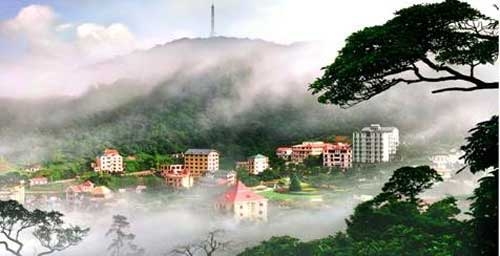Xuan Son National Park becoming tourist hotspot
 |
About 120 km from Hanoi, Xuan Son National Park covers more than 15,000 hectares. It is the 12 th largest national park in Vietnam with 84 percent forest coverage.
With pure water and clean air, temperatures in Xuan Son average 22-23 degrees Celsius all year round. One day at the park sees the four seasons: the morning is as cool as spring, noon is as warm as summer, the wind in the afternoon is as gentle as that in autumn and the evening has a little winter coldness.
The park is home to 365 animal species, including 46 listed in Vietnam’s Red Book and 18 others in the World Red Book. Xuan Son is home to typical species of the northwestern region such as langurs, gibbons, civets, squirrels, bears, leopards, pheasants and peacock pheasants.
The park has 726 species of vascular plants. At the intersection of flora from Indo-Malaysia and China’s Huanan regions, Xuan Son’s vegetation is dominated by chestnut trees, oaks and magnolias alongside such typical plants of the northwestern region as “tau muoi” (Vatica odorata), “s ao mat quy” ( Hopea mollissima), “ cho chi” (Parashorea chinensis), “ nghien” ( Burretiodendron hsienmu ) and “kim giao” ( Nageia fleuryi).
Besides its rich flora and fauna, the park also owns numerous striking natural landscapes like three 1,000 meter-plus high peaks, namely Mount Voi, Mount Ten and Mount Can as well as hundreds of caves, streams and waterfalls.
Additionally, ethnic groups residing in the park still maintain their own culture in costumes, festivals, handicrafts, brocades, dances and cuisine. Moreover, Xuan Son together with Tam Dao in Vinh Phuc Province and Ba Vi in Hanoi form a triangle of spectacular landscapes and legendary sites.
Thanks to the foregoing advantages, it is favourable to develop numerous types of tourism like eco-tourism, adventure, medical and community tourism. The park now welcomes 5,000 – 10,000 visitors every year, 5 – 10 percent of them tourists.
However, the site’s tourism business is spontaneous and lacking of a concrete plan and orientations, thus it has neither drawn large numbers of visitors nor earned healthy profits.
In the short term, the Phu Tho People’s Committee is focusing on developing essential infrastructure in Xuan Son National Park. A number of preferential policies have also been issued to call upon businesses to invest in rural and mountainous areas which have potential for tourism.
Currently, many projects are being fast-tracked, for example an 84 billion VND (4 million USD) project to build facilities for the route Lap hamlet – Tho Than cave – Na cave – Lung Troi waterfall; a 105 billion VND project to construct a tourist information centre, lodging, a nature museum and roads; and a 6.772 trillion VND project to build a 54 km road connecting the park and the temple of Hung Kings who founded Vietnam.
The province has worked out a plan for the construction of a cable route linking Mount Voi, Mount Ten and Mount Can, offering tourists a clear view over Hoa Binh and Son La hydropower plants, Tam Dao tourism site and the Hung Kings temple.
The investment in Xuan Son National Park is hoped to reduce poverty and tap the existing potential of the locality. It is expected to receive 15,000 domestic and foreign tourists by 2015 and 30,000 by 2020.
What the stars mean:
★ Poor ★ ★ Promising ★★★ Good ★★★★ Very good ★★★★★ Exceptional
Latest News
More News
- The destinations powering Vietnam’s festive season travel demand (December 04, 2025 | 18:33)
- Vietnam named among the world’s most exciting winter destinations (December 04, 2025 | 15:10)
- Phu Tho emerges as northern Vietnam’s new tourism hub (December 01, 2025 | 17:00)
- Vietjet completes Airbus A320/A321 updates ahead of deadline (December 01, 2025 | 09:49)
- Vietjet resumes Con Dao flights from early December (November 28, 2025 | 15:24)
- Free tickets, Lunar New Year promotions on offer at Vietjet Mega Livestream (November 26, 2025 | 15:32)
- Scandinavian Airlines and Vietnam Airlines broaden agreement with new routes (November 25, 2025 | 17:04)
- Halong Cruise Port welcomes over 3,100 international visitors (November 12, 2025 | 18:06)
- Vietnam.travel climbs to second place in Southeast Asia website rankings (November 12, 2025 | 18:01)
- Cat Ba named among Southeast Asia’s top island adventures (November 11, 2025 | 18:09)


















 Mobile Version
Mobile Version